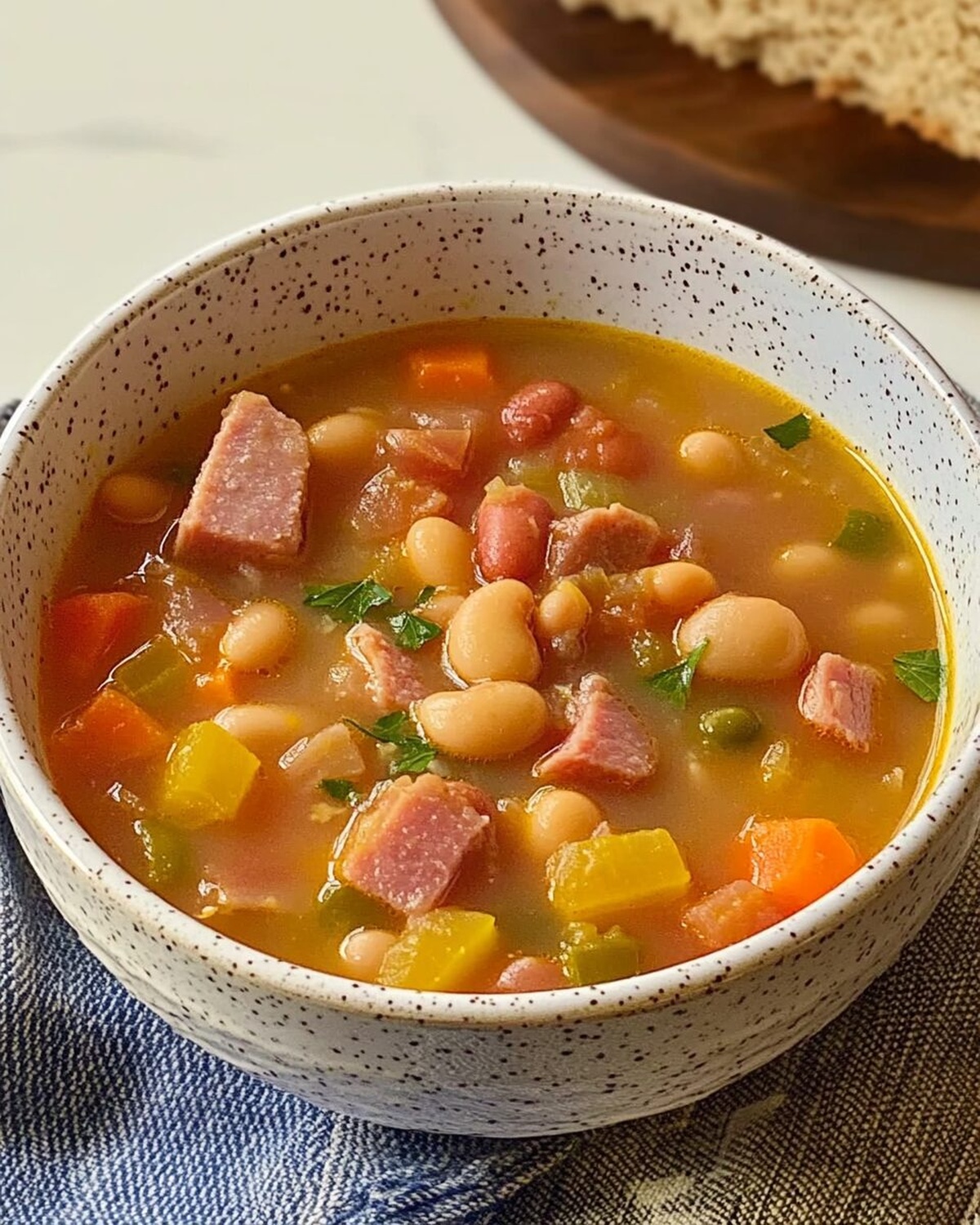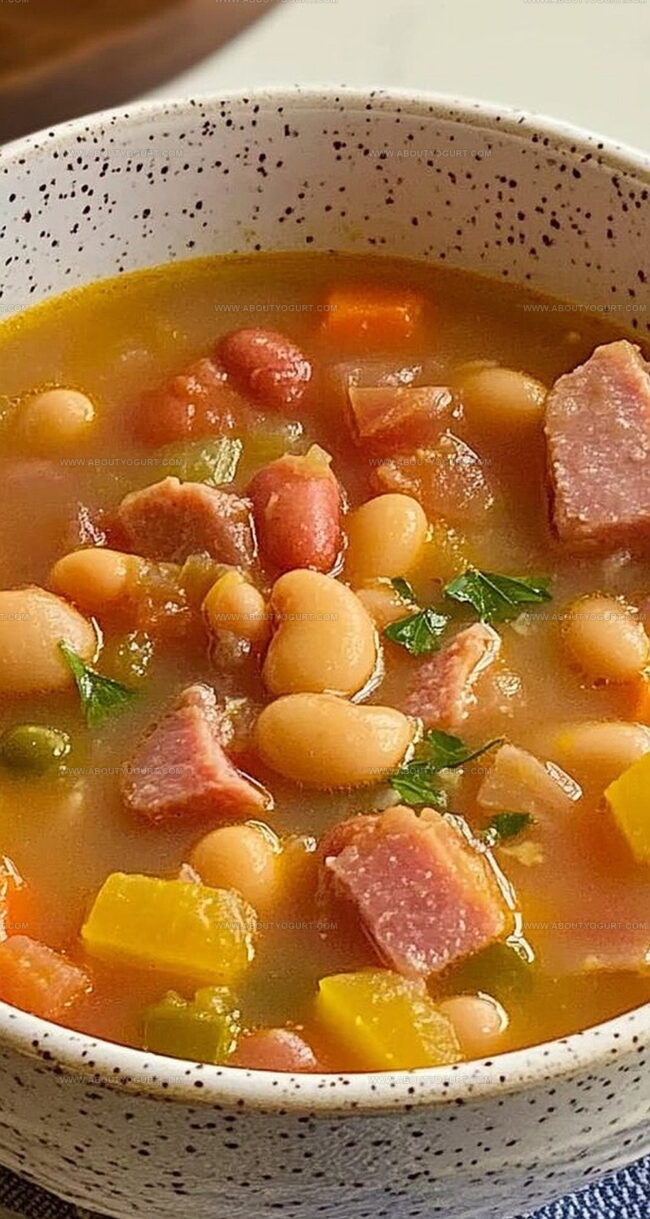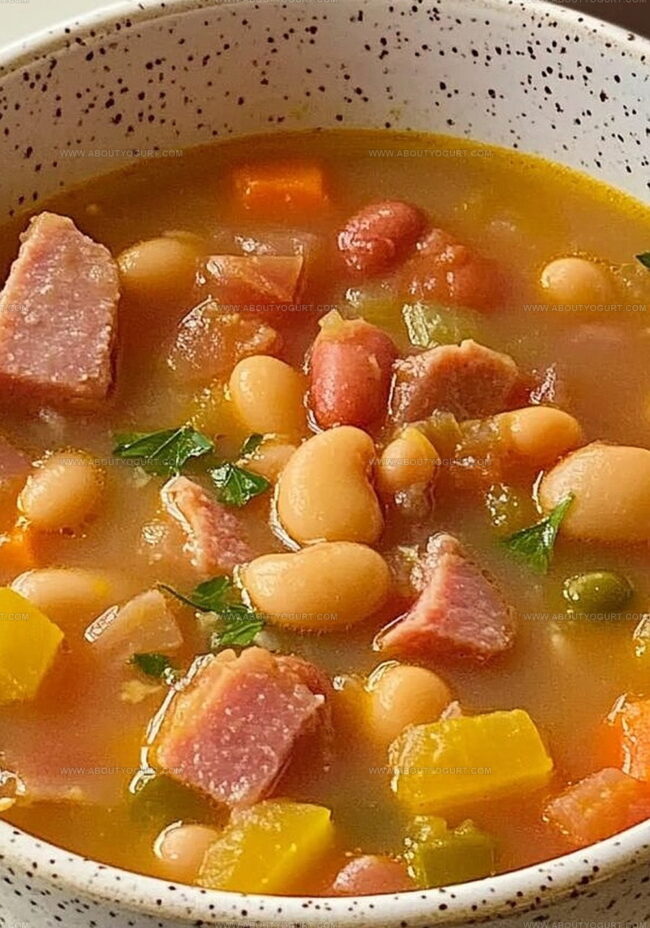Cozy Bean and Ham Soup Recipe: Heartwarming Winter Magic
Hearty bean and ham soup warms your soul on chilly evenings with its rich, comforting flavors.
Aromas of smoky ham and tender legumes fill the kitchen, promising a delightful meal.
Generations of home cooks have perfected this classic dish, blending traditional ingredients with love.
Chunks of savory meat mingle with soft beans, creating a symphony of textures.
Each spoonful tells a story of rustic comfort and nourishing goodness.
Simple yet satisfying, this recipe brings warmth and joy to your table.
You’ll find yourself craving every last drop of this delicious, soul-soothing soup.
Why Everyone’s Hooked on Bean and Ham Soup
What You Need for the Best Bean and Ham Soup
Main Protein:Beans and Vegetables:Liquid and Seasoning Base:Easy Steps to Make Bean and Ham Soup Like a Pro
Step 1: Prepare the Beans
Rinse dried beans thoroughly under cool running water. Submerge beans in a spacious container filled with water.
Allow beans to soak for a full night or minimum 8 hours to soften and reduce cooking time.
Step 2: Initial Bean Cooking
Drain soaked beans completely.
Transfer beans to a large cooking pot. Cover beans with water by approximately one inch.
Bring water to a rolling boil over medium heat. Reduce temperature and simmer for 30 minutes.
Drain beans again.
Step 3: Combine Soup Base Ingredients
Toss these ingredients into the pot:Step 4: Add Flavor Boosters
Incorporate these flavor-enhancing ingredients:Step 5: Slow Simmer the Soup
Pour chicken broth to completely cover all ingredients.
Set stove to low heat. Allow soup to gently simmer for 8 hours.
Stir occasionally and add extra broth if needed to maintain ingredient coverage.
Step 6: Final Seasoning
Remove ham bone if used.
Taste and add salt according to preference. Continue simmering for an additional 1-2 hours to develop deep flavors.
Step 7: Serve and Enjoy
Discard bay leaves before serving. Ladle hot soup into bowls and savor the rich, comforting flavors.
Smart Cooking Tips for Bean and Ham Soup Success
Fun Flavor Twists for Bean and Ham Soup Fans
What to Serve with Your Bowl of Bean and Ham Soup
Best Ways to Store Bean and Ham Soup for Later
All Your Bean and Ham Soup Questions, Answered
Soaking beans helps reduce cooking time, makes them easier to digest, and helps remove some of the compounds that can cause digestive discomfort.
While you can use canned beans, dried beans provide a better texture and flavor for this slow-cooked soup. Canned beans may become mushy during the long cooking process.
A ham bone adds extra flavor, but you can substitute with additional diced ham or even skip it. The recipe will still be delicious with the other ingredients.
The beans are done when they’re tender and can be easily mashed with a fork. They should be soft but not falling apart completely.
Print
Bean and Ham Soup Recipe
- Total Time: 18 hours
- Yield: 6 1x
Description
Hearty bean and ham soup brings comfort straight from grandma’s kitchen, warming souls with rich, smoky flavors. Generations of home cooks have perfected this classic dish, inviting you to savor each spoonful of rustic, satisfying goodness.
Ingredients
Main Protein:
- 1.5 pounds ham (including ham bone)
- 1 (20 ounces) dried 15-bean soup mix
Vegetables:
- 2 carrots, chopped
- 2 celery stalks, chopped
- 1 onion, chopped
- 1 (14.5 ounces) can diced tomatoes, undrained
- 2 bay leaves
Liquid and Seasonings:
- 4 cups vegetable broth
- 1 cup vegetable juice
- Water (enough to soak and cook beans)
- 1 tablespoon lemon juice
- 1 tablespoon Worcestershire sauce
- 1 teaspoon Dijon mustard
- 1/2 teaspoon chili powder
- 1 teaspoon dried parsley
- 1/4 teaspoon ground black pepper
- Salt, to taste
- Additional chicken broth as needed
Instructions
- Submerge dried beans in a spacious container filled with water, allowing them to soak thoroughly for a full 8-hour period or throughout the night.
- Eliminate soaking liquid and transfer beans to a large cooking vessel. Introduce fresh water, covering beans by approximately one inch. Elevate to a rolling boil over moderate heat, then decrease temperature to a gentle simmer. Cook for half an hour, then drain excess liquid.
- Consolidate prepared beans, ham, ham bone, chopped carrots, diced celery, minced onion, and canned tomatoes into the pot, ensuring even distribution.
- Incorporate vegetable broth, vegetable juice, tangy lemon juice, Worcestershire sauce, Dijon mustard, warming chili powder, fresh parsley, ground pepper, and aromatic bay leaves. Blend ingredients thoroughly.
- Pour chicken broth until all components are completely immersed. Maintain a low, consistent simmer for 8 hours, periodically stirring and replenishing liquid to prevent drying.
- After 8-hour cooking duration, extract ham bone and adjust seasoning with salt according to preference.
- Continue simmering for an additional 1-2 hours, allowing flavors to meld and intensify. Remove bay leaves before presenting the hearty soup.
Notes
- Soak beans overnight to reduce cooking time and improve digestibility, breaking down complex sugars that cause gas.
- Use low-sodium broths and ham to control salt intake, perfect for health-conscious individuals watching their sodium levels.
- Customize the soup by swapping ham with smoked turkey or plant-based protein for vegetarian and lighter protein options.
- Freeze extra portions in airtight containers for convenient meal prep, maintaining flavor and texture up to 3 months.
- Prep Time: 8 hours
- Cook Time: 10 hours
- Category: Dinner, Lunch, Snacks
- Method: Simmering
- Cuisine: American
Nutrition
- Serving Size: 6
- Calories: 320
- Sugar: 5 g
- Sodium: 800 mg
- Fat: 10 g
- Saturated Fat: 3 g
- Unsaturated Fat: 7 g
- Trans Fat: 0 g
- Carbohydrates: 40 g
- Fiber: 10 g
- Protein: 20 g
- Cholesterol: 60 mg




Michael Thompson
Founder & Recipe Developer
Expertise
Education
Cascade Culinary Institute – Bend, OR
ServSafe Food Handler Certification – Portland, OR
Focus: Certified in core food safety and hygiene principles for both home and professional kitchens, with emphasis on ingredient handling, kitchen cleanliness, and safe preparation methods.
Mike’s kitchen journey began with a single goal: to make everyday meals feel like something worth celebrating.
After earning his Certificate in Culinary Arts from Cascade Culinary Institute, he spent years working with local farmers and small kitchens across Oregon, learning the beauty of seasonal, small-batch cooking.
Mike’s approach is simple, cook with what’s fresh, keep it approachable, and always leave room for a little creativity. When he’s not testing yogurt marinades or designing single-serving meals, you’ll find him hiking trails or hunting down the best berries at local markets.